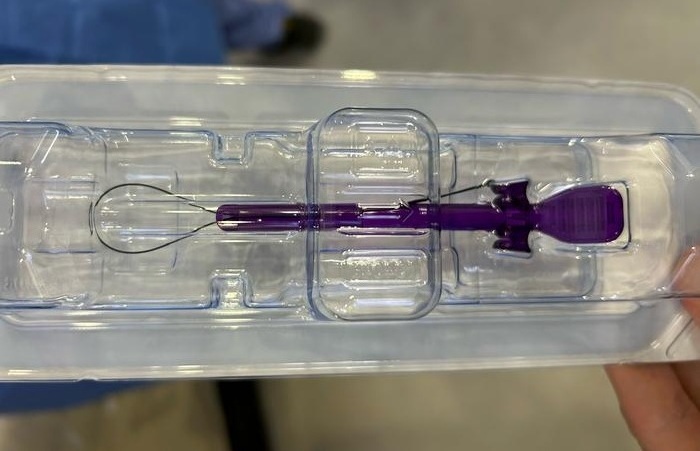Platelet-Like Particles Augment Natural Blood Clotting
|
By HospiMedica International staff writers Posted on 01 Oct 2014 |
A new class of synthetic particles could augment natural blood clotting for the emergency treatment of traumatic injuries, according to a new study.
Researchers at Georgia Institute of Technology (Atlanta, USA) and Emory University (Atlanta, GA, USA) developed the synthetic platelet-like particles (PLPs), from soft and deformable hydrogel precursor materials. The synthetic PLPs are bound to an antibody that has a high affinity to the polymerized form of fibrin, and a low affinity for fibrinogen. As a result, they are only activated when the body’s natural clotting process is triggered by thrombin-activated fibrin.
Testing done in animal models and in a simulated circulatory system suggest that the particles are effective at slowing bleeding, and can safely circulate in the bloodstream. The in vitro and in silico analyses also demonstrated that after clotting, the PLPs also actively collapse fibrin networks, an emergent behavior that mimics in vivo clot contraction. According to the researchers, the PLPs could offer doctors a new option for curbing surgical bleeding and addressing some clotting disorders without the need for transfusions of natural platelets. The study was published on September 7, 2014, in Nature Materials.
“When used by emergency medical technicians in the civilian world or by medics in the military, we expect this technology could reduce the number of deaths from excessive bleeding,” said lead author Ashley Brown, PhD, of the Georgia Tech school of chemistry and biochemistry. “If EMTs and medics had particles like these that could be injected and then go specifically to the site of a serious injury, they could help decrease the number of deaths associated with serious injuries.”
“For a patient with insufficient platelets due to bleeding or an inherited disorder, physicians often have to resort to platelet transfusions, which can be difficult to obtain,” added co-author Wilbur Lam, MD, of the Emory school of medicine department of pediatrics. “These particles could potentially be a way to obviate the need for a transfusion. Though they don’t have all the assets of natural platelets, a number of intriguing experiments have shown that the particles help augment the clotting process.”
Related Links:
Georgia Institute of Technology
Emory University
Researchers at Georgia Institute of Technology (Atlanta, USA) and Emory University (Atlanta, GA, USA) developed the synthetic platelet-like particles (PLPs), from soft and deformable hydrogel precursor materials. The synthetic PLPs are bound to an antibody that has a high affinity to the polymerized form of fibrin, and a low affinity for fibrinogen. As a result, they are only activated when the body’s natural clotting process is triggered by thrombin-activated fibrin.
Testing done in animal models and in a simulated circulatory system suggest that the particles are effective at slowing bleeding, and can safely circulate in the bloodstream. The in vitro and in silico analyses also demonstrated that after clotting, the PLPs also actively collapse fibrin networks, an emergent behavior that mimics in vivo clot contraction. According to the researchers, the PLPs could offer doctors a new option for curbing surgical bleeding and addressing some clotting disorders without the need for transfusions of natural platelets. The study was published on September 7, 2014, in Nature Materials.
“When used by emergency medical technicians in the civilian world or by medics in the military, we expect this technology could reduce the number of deaths from excessive bleeding,” said lead author Ashley Brown, PhD, of the Georgia Tech school of chemistry and biochemistry. “If EMTs and medics had particles like these that could be injected and then go specifically to the site of a serious injury, they could help decrease the number of deaths associated with serious injuries.”
“For a patient with insufficient platelets due to bleeding or an inherited disorder, physicians often have to resort to platelet transfusions, which can be difficult to obtain,” added co-author Wilbur Lam, MD, of the Emory school of medicine department of pediatrics. “These particles could potentially be a way to obviate the need for a transfusion. Though they don’t have all the assets of natural platelets, a number of intriguing experiments have shown that the particles help augment the clotting process.”
Related Links:
Georgia Institute of Technology
Emory University
Latest Critical Care News
- Biodegradable Patch Repairs Damaged Tissue After Heart Attack
- Magnetically Guided Microrobots to Enable Targeted Drug Delivery

- Smart Nanomaterials Detect and Treat Traumatic Brain Injuries Simultaneously
- Earlier Blood Transfusion Could Reduce Heart Failure and Arrhythmia in Heart Disease Patients
- 'Smart' Shirt Detects Epileptic Seizures in Real Time
- Skin Patch Measures Effectiveness of Flu/COVID Vaccines in 10 Minutes
- Complete Revascularization Reduces Risk of Death from Cardiovascular Causes
- Tiny Fish-Inspired Robots Navigate Through Body to Deliver Targeted Drug Therapy
- Coronary Artery Stenosis Could Protect Patients from Pulmonary Embolism Effects
- Sweat-Powered Sticker Turns Drinking Cup into Health Sensor
- Skin-Mounted 3D Microfluidic Device Analyzes Sweat for Real-Time Health Assessment
- New Therapeutic Brain Implants to Eliminate Need for Surgery
- Stem Cell Patch Gently Heals Damaged Hearts Without Open-Heart Surgery
- Biomaterial Vaccines to Make Implanted Orthopedic Devices Safer
- Deep Learning Model Predicts Sepsis Patients Likely to Benefit from Steroid Treatment
- Programmable Drug-Delivery Patch Promotes Healing and Regrowth After Heart Attack
Channels
Surgical Techniques
view channelNovel Endoscopy Technique Provides Access to Deep Lung Tumors
Detecting lung cancer early can save lives, but diagnosing small tumors deep in the outer regions of the lungs remains a major clinical challenge. Although CT scans frequently identify tiny suspicious... Read more
New Study Findings Could Halve Number of Stent Procedures
When a coronary artery becomes acutely blocked during a heart attack, opening it immediately is essential to prevent irreversible damage. However, many patients also have other narrowed vessels that appear... Read morePatient Care
view channel
Revolutionary Automatic IV-Line Flushing Device to Enhance Infusion Care
More than 80% of in-hospital patients receive intravenous (IV) therapy. Every dose of IV medicine delivered in a small volume (<250 mL) infusion bag should be followed by subsequent flushing to ensure... Read more
VR Training Tool Combats Contamination of Portable Medical Equipment
Healthcare-associated infections (HAIs) impact one in every 31 patients, cause nearly 100,000 deaths each year, and cost USD 28.4 billion in direct medical expenses. Notably, up to 75% of these infections... Read more
Portable Biosensor Platform to Reduce Hospital-Acquired Infections
Approximately 4 million patients in the European Union acquire healthcare-associated infections (HAIs) or nosocomial infections each year, with around 37,000 deaths directly resulting from these infections,... Read moreFirst-Of-Its-Kind Portable Germicidal Light Technology Disinfects High-Touch Clinical Surfaces in Seconds
Reducing healthcare-acquired infections (HAIs) remains a pressing issue within global healthcare systems. In the United States alone, 1.7 million patients contract HAIs annually, leading to approximately... Read moreHealth IT
view channel
EMR-Based Tool Predicts Graft Failure After Kidney Transplant
Kidney transplantation offers patients with end-stage kidney disease longer survival and better quality of life than dialysis, yet graft failure remains a major challenge. Although a successful transplant... Read more
Printable Molecule-Selective Nanoparticles Enable Mass Production of Wearable Biosensors
The future of medicine is likely to focus on the personalization of healthcare—understanding exactly what an individual requires and delivering the appropriate combination of nutrients, metabolites, and... Read moreBusiness
view channel
Philips and Masimo Partner to Advance Patient Monitoring Measurement Technologies
Royal Philips (Amsterdam, Netherlands) and Masimo (Irvine, California, USA) have renewed their multi-year strategic collaboration, combining Philips’ expertise in patient monitoring with Masimo’s noninvasive... Read more
B. Braun Acquires Digital Microsurgery Company True Digital Surgery
The high-end microsurgery market in neurosurgery, spine, and ENT is undergoing a significant transformation. Traditional analog microscopes are giving way to digital exoscopes, which provide improved visualization,... Read more
CMEF 2025 to Promote Holistic and High-Quality Development of Medical and Health Industry
The 92nd China International Medical Equipment Fair (CMEF 2025) Autumn Exhibition is scheduled to be held from September 26 to 29 at the China Import and Export Fair Complex (Canton Fair Complex) in Guangzhou.... Read more















